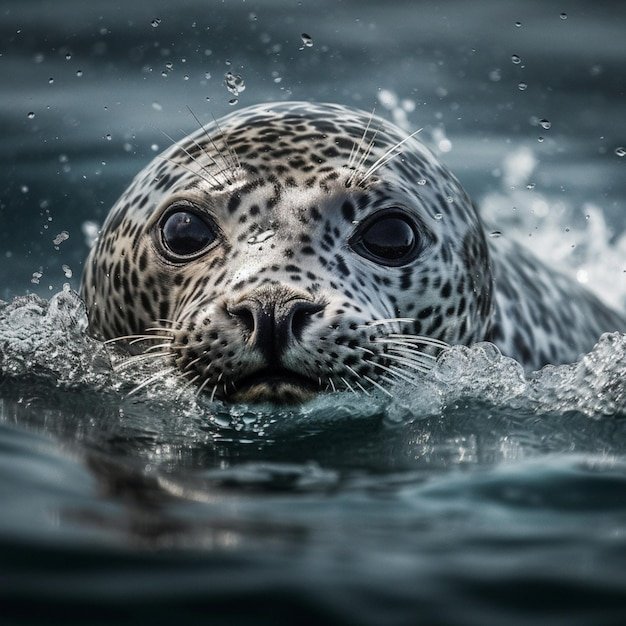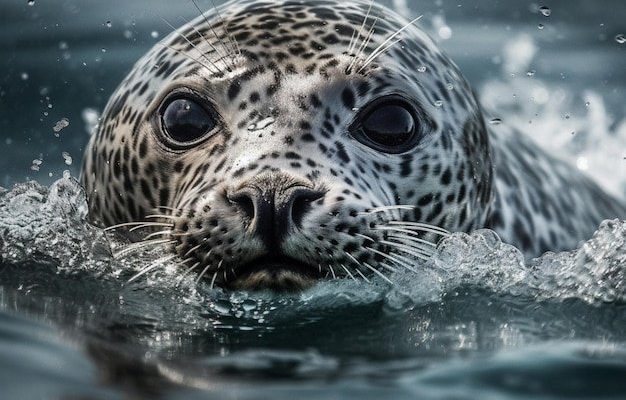
Imagine diving deep into the ocean, surrounded by icebergs and swirling currents. The leopard seal navigates this icy realm with grace and skill. Much like an athlete honing their craft, the leopard seal has evolved over time to meet the demands of its surroundings. From its sleek body to specialized hunting techniques, let’s take a closer look at the remarkable traits that make this animal a master of the underwater world.
Sleek Body Design
The leopard seal’s body is one of its most striking adaptations. With its streamlined shape, this animal slices through the water like a hot knife through butter. You might be wondering why this is so important. A streamlined body reduces water resistance, allowing the leopard seal to swim swiftly and efficiently.
This design isn’t just for speed; it also helps the seal conserve energy. In the cold Antarctic waters, energy is precious. The less energy spent on swimming means more energy available for hunting and foraging. Think of it as an athlete running in the perfect gear—every little detail counts when you’re trying to stay ahead, or in this case, stay alive.
Powerful Flippers
Leopard seals possess large, powerful front flippers that are crucial for propulsion. These flippers help them navigate through the water with incredible agility. When the seal propels itself forward, those flippers act like wings, giving it the ability to change direction quickly and maneuver around obstacles.
Imagine swimming with a paddle versus without one. The difference is night and day! The leopard seal’s flippers let it glide smoothly while also generating the necessary thrust to chase after prey. This adaptability is key when hunting. Speaking of hunting…
Impressive Hunting Skills
Leopard seals are fierce predators, feeding on a diet that includes fish, squid, and even penguins. Their hunting technique is a fascinating adaptation that showcases their intelligence and strength. When they hunt, they often employ a strategy of stealth, swimming quietly and using the icy waters to their advantage.
Here’s the thing: leopard seals can stay underwater for up to 20 minutes while they look for food. This ability allows them to cover vast areas silently. When it’s time to strike, they use a combination of speed and surprise. Imagine you’re at a game of hide and seek; the longer you stay hidden, the better your chances are of catching someone off guard!
Thick Blubber Layer
The extreme cold of the Antarctic waters requires special insulation, and the leopard seal’s thick layer of blubber provides just that. This fat layer keeps the seal warm and protects it from freezing temperatures, allowing it to swim comfortably in icy waters.
Blubber doesn’t just keep them warm—it also serves as an energy reserve. When food is scarce, this stored energy can be vital for survival. Picture a cozy blanket on a freezing night; that’s what blubber does for leopard seals. It’s one of nature’s best adaptations for life in the cold.
Sharp Teeth for Gripping
If you’ve ever looked at a leopard seal’s jaw, you might notice its sharp, conical teeth. These teeth are perfect for gripping slippery prey, like fish and squid. Unlike the flat teeth of a herbivore, sharp teeth help the leopard seal hold onto its food, preventing it from slipping away.
But it’s not only about gripping prey; those teeth can help them defend themselves against threats, including aggressive competitors. In the ocean, every little advantage counts, and sharp teeth give the leopard seal an edge in survival.
Camouflage for Stealth
You might also be surprised to learn that leopard seals have a unique coat that helps them blend into their icy surroundings. The pattern of their fur resembles the shadows created in the water, making it difficult for prey to spot them. This camouflage is crucial for hunting because it gives leopard seals the element of surprise.
Think about it: if you’re hiding in plain sight, your chances of success greatly increase. This adaptation allows them to stalk their prey without being detected, showcasing another layer of their impressive skills as hunters.
Adaptations to Breach and Communicate
Leopard seals are known for their acrobatic behavior, often seen breaching the surface of the water. This isn’t just for fun; it’s an essential part of their communication and social behavior. Breaching allows them to send signals to other seals, helping them establish territory and find mates.
In addition, these playful leaps can be a way to rid themselves of parasites or simply to enjoy the sensation of being airborne. Just like us, they have their ways of expressing joy and maintaining health—sometimes, a little leap into the air can lift your spirits.
The Importance of Adaptations
All of these adaptations work together to help the leopard seal thrive in its icy habitat. Each characteristic plays a role, from hunting efficiency to temperature regulation. These seals remind us how remarkable evolution can be, perfectly shaping an animal for survival in its environment.
As you can see, the leopard seal is more than just a pretty face in the ocean; it’s a well-designed marvel of nature. Understanding these adaptations helps us appreciate the delicate balance of life in the Antarctic and emphasizes the importance of conservation efforts to protect these incredible creatures.
The leopard seal isn’t just a survivor—it’s a master of its domain. By adapting to the frigid waters and unique challenges of its habitat, this animal showcases the power of evolution and the incredible capabilities of nature. So next time you think about seals, remember the leopard seal’s superhero status in the underwater world!

